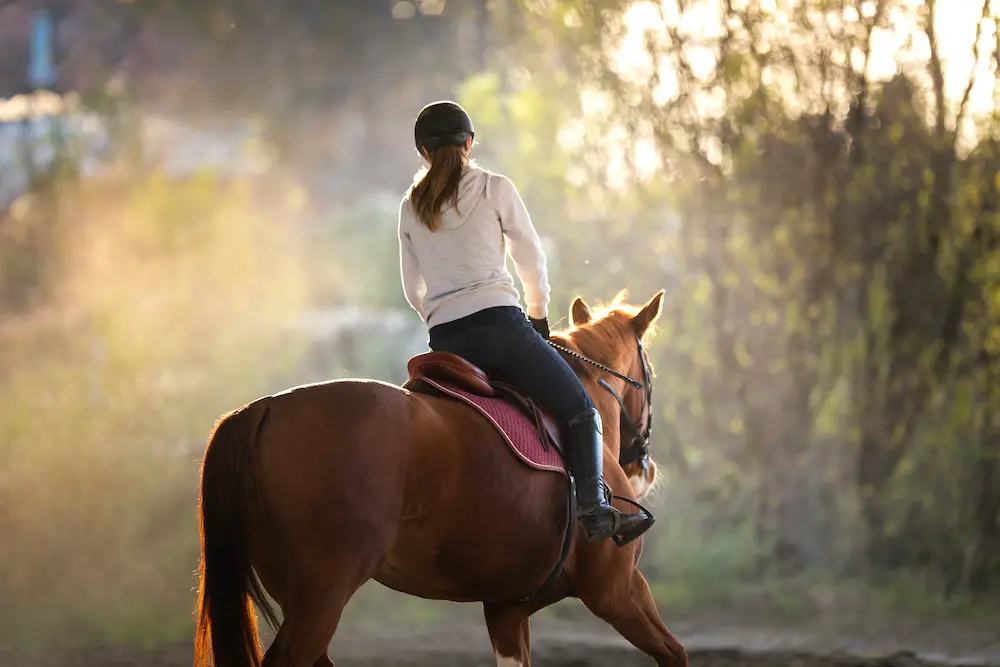It’s no surprise if you are a heavier person and wondered whether riding your horse will hurt them or not.
After all, your horse is like your baby and you wouldn’t want to hurt them or even if it’s not your pet, you wouldn’t want to cause any muscle strain on the horse.
This is why we keep getting asked “Is there a weight limit for horseback riding?“
There isn’t exactly a weight limit but as a general rule, the weight limit for horse riding can be set under 20% of the horse’s total weight.
Keep in mind that this includes your weight as well as the tack.
That said, many factors come into play to determine the weight limit for horse riders, and that’s what we’ll share today.
Weight Limit for Horse Riding
Before we discuss weight limits for horseback riding, we have to say that it is commendable you are actually doing so.
It means that you care about the well-being of your four-legged friend and want to take a responsible and mature approach to ride a horse.
As stated earlier, there isn’t a formal weight limit for horseback riding, but reputable horse-riding tour operators and equestrian centers tend to have a maximum weight limit set for riders.
You may notice that these weight limits for horseback riding tend to differ a little from one establishment to another mainly because every center has different kinds of horses.
This can impact the weight that the horse can accommodate.
There are a number of reasons there should be a weight limit for horse riders, and for some, it may seem as if it is discriminatory, this is not the intention.
Why Is There a Weight Limit for Horseback Riding?
A weight limit for riding a horse not only ensures the well-being of the horse but the safety of the rider as well.
When a horse carries someone and/or something too heavy, it can cause a range of issues for them which can have adverse effects and can even appear surprisingly quickly.
A few of these physical issues can include:
- Strained and sore muscles
- Rub sores caused by the tightly pressed saddle against the horse’s back
- Pinching of the nerves due to added pressure
Any horse lover is truly interested to keep their horse in a good condition and healthy.
This is particularly important for riders who use a horse for commercial purposes, for example, in the tourism industry.
An injured horse can cause a major negative impact on the income.

Can I Ride a Horse if I’m Overweight?
The weight limit is kept for the rider’s safety too.
If you are an overweight individual and your horse is unable to carry your weight or if the horse isn’t strong enough to hold your weight, it can impact you in ways like:
- the horse biting the rider’s legs to signal they are in discomfort,
- showing signs of stress and irritability,
- and rearing or bucking in an attempt to drop the rider.
All these situations can potentially be dangerous. It is the horse’s way to object to the excess weight and communicate displeasure.
Then some issues can go beyond the potential reactions that the horse can have.
In addition to being overweight, if you are also unbalanced or inexperienced, you could end up sitting incorrectly in the saddle which will lead to an uneven distribution of weight as the horse moves.
This will substantially increase your risk of falling. Also, a heavier rider has a higher chance of injury if they fall from the horse.
That’s because the impact with the ground ends up being harder compared to a rider who is lighter.
Another aspect is mounting and dismounting the horse.
A heavier inexperienced rider often finds it more difficult to create the momentum necessary to push themselves off the ground or the mounting block to throw their leg over and across the horse.
This can further be problematic for the horse because they can get agitated and stressed throughout this mounting process.
Lastly, if the rider falls during their ride, they may struggle to get back on the horse without help.
How Do I Know Whether My Horse Can Carry My Weight?
While the 20% guideline isn’t exactly set in stone, you need to use common sense before adding unnecessary weight on the horse by seeing how old they are, how fit they are, and the breed they are.
However, if you are unable to guess if the horse can carry your weight or not, then we recommend using this fantastic calculator that allows you to enter your horse’s weight, your weight, and the weight of the tack.
If all of this falls inside the 20% weight range, then you are definitely good to go.
For those who aren’t exactly sure how much their horse weighs, you can also use this calculator to figure it out.
What Kind of Horse Can Carry a Heavier Rider?
Thankfully, there are different breeds of horses that are capable of carrying heavier riders.
Some of these breeds include:
- Friesian
- Percheron
- Clyesdale
- Westphalian
- Spanish-Norman
- Irish Draft
- Belgian Draft
Other Factors to Consider
Regardless of the breed of horse and the 20% weight limit rule, there are other factors you need to consider.
For starters, look at the horse’s build. This and especially the back length and strength will directly impact its ability to carry heavyweight.
Also, look at their height and weight. A larger horse is more likely to hold all that weight instead of a smaller horse.
Lastly, take a look at the horse’s general condition. Just as we humans, they also need to have a proper exercise routine they need to follow regularly to remain fit.
A fit horse can take a good amount of weight on the back.
Is There a Weight Limit for Riding a Horse: The Conclusion
The weight limit for horse riding maybe around 20% of the horse’s total weight, but keep in mind all the other factors.
Remember that the weight limit is not only there to keep your horse safe but also you.
